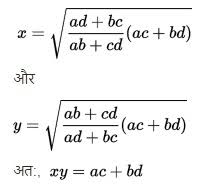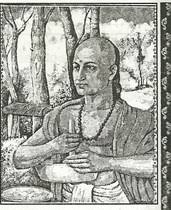Who was Mahaviracharya?
There is an elaborate description of mathematics in Jain literature (500 B.C -100 B.C).Jain gurus knew how to solve quadratic equations. They have also described fractions,algebraic equations, series, set theory, logarithms and exponents in a very interesting manner.Jain Guru Mahaviracharya wrote Ganit Sara Sangrahain 850A.D., which is the firsttextbook on arithmetic in present day form. The current method of solving Least commonMultiple (LCM) of given numbers was also described by him. Thus, long before JohnNapier introduced it to the world, it was already known to Indians

Childhood & Early Life
The Jain texts state that Mahavira was born in 599 BC into a royal family of Kshatriyas, in Bihar, India. His childhood name was 'Vardhamana', which means "One who grows".
His parents were King Siddartha of Kundgraam and Queen Trishala. His father was the chief of the Jnatrika clan, an indigenous oligarchical tribe. Hailing form a royal family, he had all the luxuries of life at his disposal.
He grew up to be a very brave boy and once brought a fierce serpent under control. This earned him the name “Mahavira” meaning “Great Warrior” in Sanskrit.
His father’s kingdom was a democratic one in which the king was chosen by voting. Thus he was exposed to the values of freedom and equality from a young age, and these would influence his thinking in future as well.
Later Years
The various luxuries of life gave no satisfaction to Mahavira and he experienced an unquenchable thirst for spiritual enlightenment. So at the age of 30 he decided to leave behind his worldly life and family and embarked on a journey of self-discovery in order to seek the spiritual truth.
Traditional religious practices of that time were based on rites and rituals. But Mahavira found no peace of mind through these mindless rituals as they could not offer him the answers to the questions he sought.
He wanted to obtain spiritual release from the karmic cycle of life and death and realized that it was possible only through inward self-discipline. Thus he started living a life of severe austerity and radical physical asceticism.
He wore the same clothes for a period of around one year and after that, he discarded his clothes and walked about naked. He decided to have no possessions at all, not even a bowl for obtaining alms or drinking water; he accepted alms in the hollow of his palm.
He strictly followed the principle of ahimsa or non-violence. He allowed insects to crawl all over his body and did not harm them even when they bit him. He endured all the physical hardships of his ascetic life peacefully. People were taken aback by the sight of his naked and injured body and insulted him, yet he very patiently endured all the abuses hurled at him.
After a period of twelve and a half years of such a severe lifestyle, he finally attained ‘Kevala jnana’, meaning “absolute knowledge” or “supreme knowledge”. Thus he attained the realization of perfect perception, knowledge, power, and bliss.
The era in which Mahavira lived was a turbulent period marked by the cultural domination of the Brahmans who claimed that they were purer than the other castes. Several members of the Kshatriya caste opposed the rituals and practices of the Brahmans which included large-scale Vedic sacrifices (yajna) that involved the killing of many animals. Mahavira became one such individual who advocated non-violence and opposed the killing of innocent creatures.
He traveled all over India teaching his philosophy which was based on eight cardinal (law of trust) principles, three metaphysical, and five ethical. The ethical principles were “Ahimsa” or non-violence, “Satya” or truthfulness, “Asteya” or non-stealing, “Brahmacharya” or chastity, and “Aparigraha” or non-possession.
Having attained the Kevala jnana at the age of 42, Mahavira preached and taught for the next 30 years. His teachings are as relevant in today’s contemporary world as they were in the era he lived in.
Major Works
Mahavira is greatly respected as the highest authority on Ahimsa. He advocated the principle of non-violence under all circumstances and his teachings tremendously influenced several great personalities like Mahatma Gandhi and Rabindranath Tagore.

